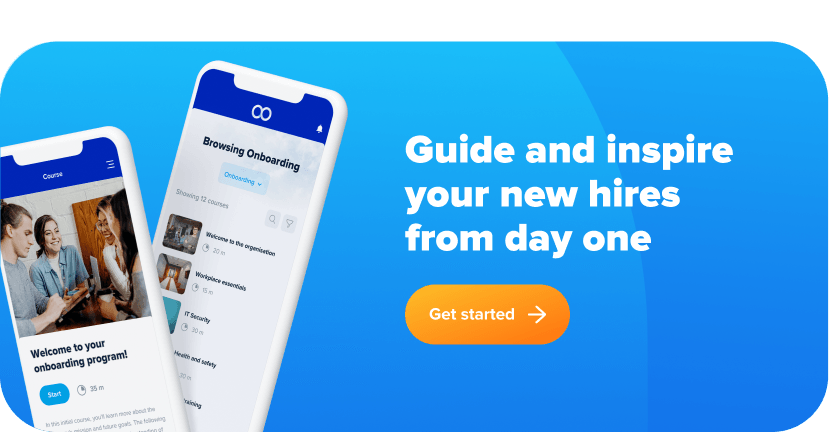Employee onboarding is becoming more of a focus within the workplace and leaders are seeking new ways to improve this process for their employees. Why? A great onboarding boosts employee experience and can increase retention by 50%! We will guide you in creating an effective onboarding experience that will impact your business in only 4 phases.
Onboarding process definition
Let’s start by defining what exactly an onboarding process is. According to The Society for Human Resource Management (SHRM), employee onboarding is “the process of integrating a new employee with a company and its culture, as well as getting a new hire the tools and information needed to become a productive member of the team”. Essentially, employee onboarding is the process of getting a new employee up to speed. For HR managers and direct reporting managers specifically, their responsibility is to help the new employee feel comfortable and confident about their new role, as well as help them get familiar with the company’s goals and culture. To do this, it’s important to walk through all the steps of the onboarding process and ensure your new hires understand each aspect.
The internet is full of long lists of onboarding tips and activities that make for a perfect employee onboarding process. These can be a helpful resource but often it is not a case of one size fits all. What might be an essential step for onboarding in one organization may not be as important for others, which means you need to be selective about the onboarding activities you choose to have in your organization.
In addition, since high employee retention is precious to most CHROs, it is critical that you use the onboarding process to create a strong cultural match between the new hire and the organization, and that these strong bonds are created as quickly as possible. Additionally, it is critical for most organizations that the employees’ ramp up time leads to early productivity.
The importance of staff onboarding
Having an effective onboarding process brings multiple benefits and positive outcomes. Starting from employee engagement and retention, building a plan for new hires offers a win-win situation and a great investment for the organization. Besides, in the new era of remote work, a digital onboarding process can’t be optional.
The advantages of building a solid and agile staff onboarding process can be summarised in a list of five main points:
- Improved employee retention, motivation and teamwork
- Clear and reinforced company culture
- Faster time to proficiency and job role contribution
- Accelerated talent development
- Promotion of diversity & inclusion
Employees can focus more on productivity and collaboration by nurturing their work motivation from the beginning of a new job. When expectations are aligned, and the company culture is embodied, teams can start their shared journey toward the desired objectives. Teamwork in the workplace is the most efficient way to find smarter solutions and achieve the best results in the long term.
Now, how long does the standard employee onboarding process take for new hires? The average length of onboarding can extend from one to three months, depending on the nature of the role, the size of your department, and the level of training and supervision required.
Some roles might need more or less time than others; an experienced executive will already have a good grasp of what’s expected of them at work and so they can get right down to business, while a new college graduate may need more time to learn about the industry, their specific role in the company, and how their work fits into the whole picture.
In fact, studies have shown that:
- Only 29% of new hires feel completely settled after a week-long onboarding.
- New employees have a 25% productivity rate in the first month, 50% in the second and 75% in the third.
- It can take up to a full year for new hires to reach their peak potential.
Many people see onboarding as a special period where they’re exempt from all the usual expectations of their job, but that isn’t really true. Onboarding should be seen as an opportunity for both HR and employees to set realistic expectations for everyone involved.
4 phases of employee onboarding
Creating a successful onboarding experience is a great way to get your employee retention rates high and also avoid excessive check-ins during regular workflows in the future.
Keep reading to learn the necessary phases of an onboarding program.
Phase 1: Preboarding
Once you’ve accepted your offer letter and you’re starting off day one at a new job, there’s a lot to learn. It’s easy to get overwhelmed by all the new information if you don’t have a plan in place for how to take it all in.
During phase one, known as preboarding, the employee goes through a checklist of things that introduce you to their role within the company. This will include things like a corporate overview, employee handbook, compliance policy, social media and blogging policy, benefits package information, dress code information, and a list of resources to help the employee be successful in the position.
Establishing a smooth preboarding practice through e-learning in a modern LMS (Learning Management Systems) is an onboarding best practice that will make for a great start to the employee experience. It can also help the new employee get a solid kick-off even before they start in their new job!
This phase is important for several reasons: it allows for the employee to have a lay of the land before they begin their work; it lets you ensure that you create a great first impression and everyone within and outside of your company has an accurate portrayal of your company culture; and it gives you an opportunity to establish how you want to communicate with each other moving forward.
Phase 2: Onboarding and welcoming new employees
Phase two of employee onboarding is orientation, or the time when new employees first arrive at your organization. In this period, you’ll need to introduce employees to senior management and other key people in the company.
During this phase, you’ll help people transition into their new roles—ideally with plenty of support from existing employees and co-workers, who will be here to answer any questions they have and introduce them to key leaders in your organization. The goal is to get them familiar with your company culture, development plans and its policies, including all the ways they can be involved and make positive contributions to their work.
Although it will be a relatively short period, here’s where you’ll also want to make sure that everyone is clear on any expectations regarding interpersonal relationships between employees and management.

Phase 3: Training
Employee training is arguably the most important step in the onboarding process. Too many businesses and organizations expect new recruits to just know their jobs, without giving them the time and support they need to be successful.
In phase three, employers give new employees a clear picture of what they should expect from this job, while also outlining what they can expect from the company. The training phase is perhaps best done through a combination of workshops, seminars, and shadowing.
Employers should make sure there are plenty of opportunities for employees to ask questions, no matter how simple or dumb they might seem. Fostering a culture of employee engagement during the early stages is also a great way to show your new hires in the first week itself that your work environment is a positive one.
Phase 4: Transition to the new role
Recently hired employees need to be slowly integrated into the team and office culture. In the fourth phase, the employee will transition from an individual contributor with limited responsibility to a full-fledged team member. The transition period is extremely important for a new hire. In phase four, it takes a while to get accustomed to the new environment and responsibilities. But even then, it is hard to adjust and find that perfect fit.
In order to have a successful ongoing development of their competency and transition into their new roles, the new employee has to address two main challenges:
- Interpersonal relationships with peers
- Adapting their skillset for the position
Effective managers will give new hires enough time to adjust to their work environment, familiarize themselves with all company policies and procedures, and prepare for their first project. A common suggestion is to assign the new employee a buddy for a limited period of time. This will be an empowering task that can be given to the current employee and it can be a great example of peer-to-peer knowledge sharing.

Most common mistakes of staff onboarding
Once companies and HR professionals start planning their onboarding process, they could also stumble into common errors and inconveniences.
There are mainly 5 mistakes to avoid:
- The onboarding plan is missing or procrastinated. The lack of organization and transparency will result in confusion and loss of basic information like IT instructions.
- Poor communication. A lack of clear communication affects every aspect of the onboarding process, including culture and motivation.
- Goals and plans are not set. After hiring, the new role should be defined in detail and combined with precise objectives.
- Overwhelming information. It’s daunting for new hires to be entirely open during the initial time at work. Too much instruction or reading can drive down people’s enthusiasm.
- No time for feedback. A successful onboarding aims to be helpful for multiple personas in the companies. It is an opportunity to grow for employers, HR people, current workers, and new candidates. Feedback is the best way to engage employees and learn new things.
If you want to dig in deeper, we unpacked the 12 most common onboarding mistakes and how to avoid them.
Overall, underestimating the importance of employee onboarding can result in a high turnover or low job satisfaction in the long run.
Simplify the phases of onboarding with eloomi
Onboarding is more than just introducing a new hire to the office, it’s important to take the time to make sure they have all the resources they need to be successful in the long-term. It also helps to set expectations early, so that people can really think about what they want out of their position and how they want to contribute.
When you’re trying to create a process that your employees will follow, it’s important to keep in mind the fact that you don’t want to put your new hires through unnecessary work. That’s why we suggest adding eloomi’s onboarding software to your employee onboarding checklist.
It’s crucial you make your new employee onboarding experience as easy and enjoyable as possible for your new employees, so they can get up to speed with their new role. eloomi’s onboarding software can help do just that by providing employees with all the information they need right at their fingertips.






